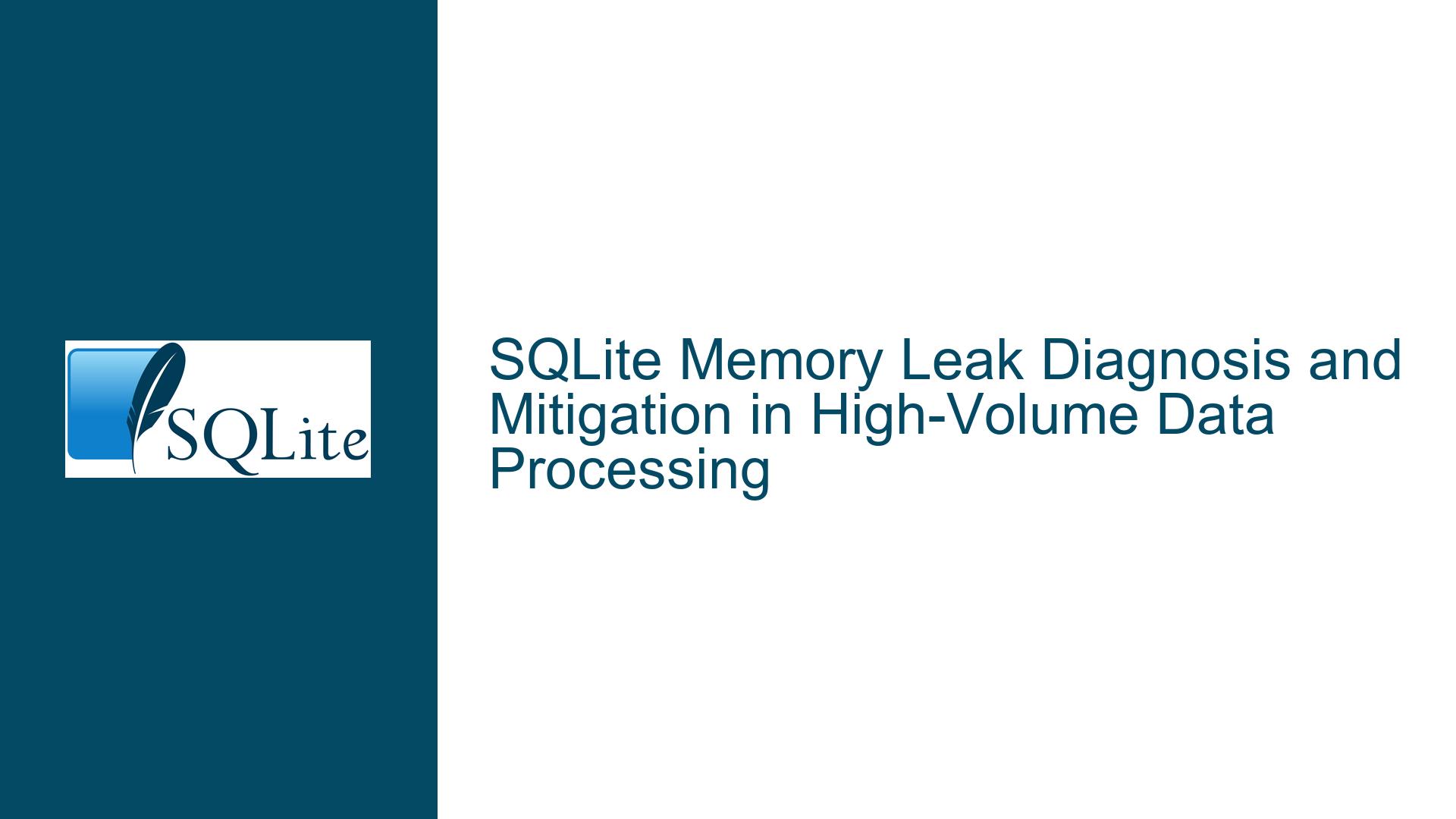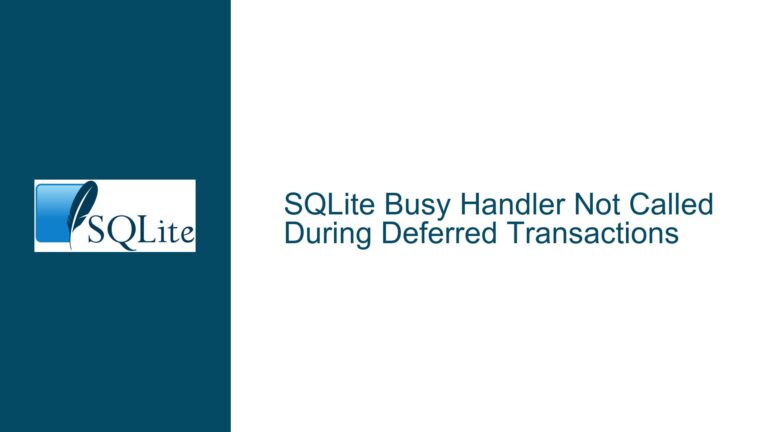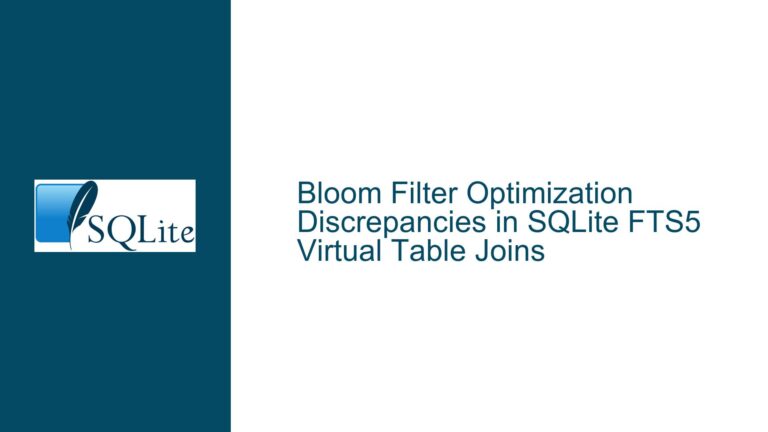SQLite Memory Leak Diagnosis and Mitigation in High-Volume Data Processing
SQLite Memory Management Fundamentals and Common Misconceptions
The core challenge revolves around unbounded memory growth in applications using SQLite for large-scale data processing. While SQLite is designed as a lightweight embedded database, its memory behavior depends heavily on API usage patterns, transaction design, and configuration parameters. The assertion that "SQLite expands memory usage without bound" contradicts its architecture, which includes multiple memory management layers. However, specific anti-patterns in application code and SQLite configuration can create the illusion of memory leaks while actually revealing resource management flaws.
Three primary memory domains exist in SQLite:
- Heap Memory: Managed through malloc/free, used for transient objects
- Page Cache Memory: Buffer for database file pages, size controlled separately
- Prepared Statement Memory: Retained for query optimization and binding contexts
A critical misunderstanding arises when developers assume sqlite3_soft_heap_limit64() constrains all memory domains. In reality, this function only limits the first category while leaving page cache and prepared statement memory uncontrolled. The original poster’s 64MB heap limit implementation failed to address other memory areas that could balloon during bulk operations.
Memory Growth Culprits in SQLite Workflows
1. Prepared Statement Lifecycle Mismanagement
Every sqlite3_prepare_v2() call allocates memory for query parsing and optimization. Failure to call sqlite3_finalize() leaves these structures in memory indefinitely. A common pitfall occurs when developers reuse prepared statements without proper reset cycles:
- sqlite3_reset() reuses the prepared statement but retains binding memory
- sqlite3_clear_bindings() must accompany resets to release parameter buffers
- Unfinalized statements maintain references to database schema objects, preventing cache truncation
2. Transactional Write Amplification
While splitting large transactions into per-page commits helps avoid exclusive lock contention, improper WAL (Write-Ahead Logging) configuration can exacerbate memory usage. Each transaction batch under WAL mode maintains private page copies until checkpointing. Without periodic checkpoints via sqlite3_wal_checkpoint_v2(), the WAL file and associated memory buffers grow uncontrollably.
3. Blob Handling and Memory Modes
SQLITE_STATIC vs SQLITE_TRANSIENT binding flags drastically affect memory ownership. Using SQLITE_STATIC with ephemeral data buffers forces SQLite to copy the data, while SQLITE_TRANSIENT allows reference counting. Misapplying these flags during bulk inserts creates duplicate data copies that evade the soft heap limit.
4. C++ Abstraction Layer Leaks
Many C++ SQLite wrappers (SQLiteCpp, SOCI, etc.) implement RAII incorrectly for SQLite objects. If the wrapper’s destructor doesn’t explicitly finalize statements or close database connections, memory leaks occur despite proper C++ object lifecycle management.
5. Unbounded Page Cache Growth
The default page cache size (2000 pages, ~2MB per 1KB page size) multiplies under heavy join operations or large index builds. Without explicit configuration via sqlite3_db_config(db, SQLITE_DBCONFIG_CACHE_SIZE, …), memory consumption scales with query complexity.
Comprehensive Memory Control Strategy for SQLite Applications
1. Instrumented Memory Profiling
Before attempting fixes, establish baseline metrics using:
valgrind --leak-check=full --track-origins=yes ./application
Combine with SQLite’s internal memory counters:
sqlite3_int64 heap_used = sqlite3_memory_used();
sqlite3_int64 pagecache_used = sqlite3_db_status(db, SQLITE_DBSTATUS_CACHE_USED, 0, 0, 0);
2. Prepared Statement Hygiene Protocol
Implement strict statement lifecycle management:
sqlite3_stmt* stmt = nullptr;
sqlite3_prepare_v2(db, "INSERT INTO pages VALUES(?1)", -1, &stmt, nullptr);
while(data_available) {
sqlite3_bind_blob(stmt, 1, data, size, SQLITE_TRANSIENT);
while(sqlite3_step(stmt) == SQLITE_ROW) { /* ... */ }
sqlite3_clear_bindings(stmt);
sqlite3_reset(stmt);
// Critical: Release application-side data after binding
free(data);
data = nullptr;
}
sqlite3_finalize(stmt); // Force finalization even if loop exits early
3. Page Cache and WAL Configuration
Optimize memory usage for bulk operations:
// Set page cache to 500 pages (adjust based on workload)
sqlite3_db_config(db, SQLITE_DBCONFIG_CACHE_SIZE, 500);
// Enable automatic WAL checkpoint every 1000 pages
sqlite3_exec(db, "PRAGMA wal_autocheckpoint=1000;", nullptr, nullptr, nullptr);
// Use exclusive locking mode for single-connection apps
sqlite3_exec(db, "PRAGMA locking_mode=EXCLUSIVE;", nullptr, nullptr, nullptr);
4. Memory Subsystem Selection
Override SQLite’s default allocator for better fragmentation control:
sqlite3_config(SQLITE_CONFIG_HEAP, malloc(256*1024*1024), 256*1024*1024, 64);
sqlite3_initialize();
For extreme memory constraints, use the memsys5 allocator:
sqlite3_config(SQLITE_CONFIG_MEMSTATUS, 0); // Disable memory statistics
sqlite3_config(SQLITE_CONFIG_HEAP, ...); // Custom memory pool
sqlite3_config(SQLITE_CONFIG_LOOKASIDE, 512, 1024); // Fast allocs for small objects
5. Batch Processing with Memory Caps
Implement application-level memory throttling:
constexpr int64_t MEMORY_LIMIT = 1024 * 1024 * 1024; // 1GB
while(work_remaining) {
process_batch();
sqlite3_db_release_memory(db); // Force page cache purge
if(sqlite3_memory_used() + get_process_memory() > MEMORY_LIMIT) {
sqlite3_exec(db, "COMMIT;", nullptr, nullptr, nullptr);
sqlite3_close(db); // Force all memory release
reopen_database_connection();
sqlite3_soft_heap_limit64(MEMORY_LIMIT / 2);
}
}
6. Blob Streaming Techniques
Avoid in-memory blob accumulation using incremental I/O:
sqlite3_blob* blob_handle = nullptr;
sqlite3_blob_open(db, "main", "pages", "content", rowid, 1, &blob_handle);
FILE* fp = fopen("largefile.bin", "rb");
char buffer[4096];
while(size_remaining > 0) {
size_t read = fread(buffer, 1, sizeof(buffer), fp);
sqlite3_blob_write(blob_handle, buffer, read, offset);
offset += read;
size_remaining -= read;
}
sqlite3_blob_close(blob_handle);
7. Connection Pool Sanitation
For multi-threaded applications, enforce connection memory discipline:
class ConnectionPool {
std::mutex mtx;
std::vector<sqlite3*> connections;
sqlite3* get_connection() {
std::lock_guard<std::mutex> lock(mtx);
if(connections.empty()) {
sqlite3* db = nullptr;
sqlite3_open_v2(":memory:", &db, SQLITE_OPEN_READWRITE, nullptr);
sqlite3_db_config(db, SQLITE_DBCONFIG_CACHE_SPILL, 1, nullptr); // Auto-spill to disk
return db;
}
auto db = connections.back();
connections.pop_back();
return db;
}
void release_connection(sqlite3* db) {
sqlite3_db_release_memory(db);
sqlite3_exec(db, "PRAGMA shrink_memory;", nullptr, nullptr, nullptr);
std::lock_guard<std::mutex> lock(mtx);
connections.push_back(db);
}
};
8. Schema Optimization for Memory Efficiency
Redesign tables to minimize memory overhead:
CREATE TABLE pages (
id INTEGER PRIMARY KEY,
content BLOB CHECK(LENGTH(content) <= 1048576) // 1MB chunking
) WITHOUT ROWID;
CREATE INDEX idx_pages_metadata ON pages(created_at)
WHERE deleted = 0 // Partial index
AND status IN ('processed', 'pending');
9. Memory-Limited Query Execution
For complex queries, enforce resource limits:
SELECT /*+ MAX_MEMORY(104857600) */ url, SUM(clicks)
FROM analytics
GROUP BY url
ORDER BY 2 DESC
LIMIT 100;
Combined with runtime configuration:
sqlite3_exec(db, "PRAGMA hard_heap_limit=1073741824;", nullptr, nullptr, nullptr);
10. Continuous Memory Monitoring Integration
Embed real-time memory tracking in the application:
class MemoryGuard {
sqlite3* db;
int64_t last_pagecache;
int64_t last_heap;
public:
MemoryGuard(sqlite3* db) : db(db) {
update();
}
void update() {
sqlite3_db_status(db, SQLITE_DBSTATUS_CACHE_USED, &last_pagecache, 0, 0);
last_heap = sqlite3_memory_used();
}
bool exceeds(int64_t limit) const {
return (last_pagecache * sqlite3_page_size()) + last_heap > limit;
}
void enforce(int64_t limit) {
update();
while(exceeds(limit)) {
sqlite3_db_release_memory(db);
sqlite3_release_memory(limit / 2);
update();
std::this_thread::sleep_for(std::chrono::milliseconds(100));
}
}
};
Final Implementation Checklist
- Validate all prepared statements with sqlite3_stmt_status(stmt, SQLITE_STMTSTATUS_MEMUSED, 0)
- Configure PRAGMA mmap_size to use file-backed memory for large reads
- Replace SQLITE_OPEN_NOMUTEX with SQLITE_OPEN_FULLMUTEX to reduce allocator contention
- Set sqlite3_config(SQLITE_CONFIG_MEMSTATUS, 0) to disable internal tracking overhead
- Use sqlite3_uri_parameter() for in-connection configuration of cache_size and page_size
- Implement periodic sqlite3_db_cacheflush() calls during idle periods
- Benchmark with SQLITE_DIRECT_OVERFLOW_READ to bypass page cache for large BLOBs
- For persistent connections, schedule hourly sqlite3_db_release_memory() calls
- Monitor sqlite3_status(SQLITE_STATUS_MALLOC_COUNT, …) for heap fragmentation
- Consider compiling SQLite with -DSQLITE_ENABLE_MEMSYS5 for alternative allocator
This comprehensive approach addresses both application-level resource management and SQLite’s internal memory configuration, providing layered defenses against memory exhaustion. By combining statement lifecycle enforcement, page cache tuning, allocator selection, and application-layer throttling, developers can maintain predictable memory footprints even when processing terabyte-scale datasets with SQLite.






